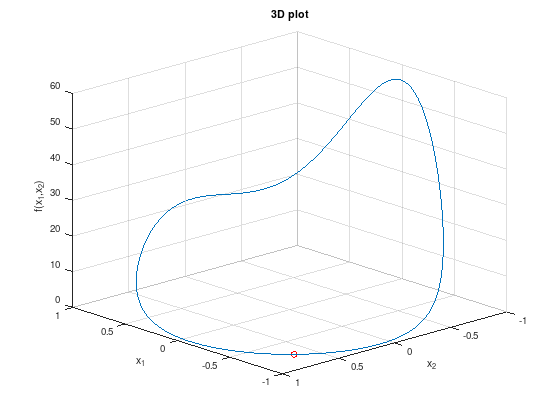RM04
Contents
RM04#
Consider the following constrained optimization problem:
\[\begin{split}
\begin{array}{lll}
\textrm{minimize} & f(x_1, x_2) &:= e^{3x_1} + e^{-4x_2} \\
\textrm{subject to} & h(x_1, x_2) &:= x_1^{2} + x_2^{2} - 1 = 0.
\end{array}
\end{split}\]
The corresponding Lagrangian is:
\[
L(x_1,x_2,\mu) = e^{3x_1} + e^{-4x_2} + \mu (x_1^{2} + x_2^{2} - 1)
\]
and the KKT optimality conditions:
\[\begin{split}
\begin{aligned}
\nabla_{x_1} L(x_1,x_2,\mu) &:=& 3e^{3x_1} + 2\mu x_1 &= 0, \\
\nabla_{x_2} L(x_1,x_2,\mu) &:=& -4e^{-4x_2} + 2\mu x_2 &= 0, \\
h(x) = \nabla_{\mu} L(x_1,x_2,\mu) &:=& x_1^{2} + x_2^{2} - 1 &= 0.
\end{aligned}
\end{split}\]
% Optimal point.
px = -0.75;
py = 0.66;
theta = 0:0.02:2*pi;
x = cos (theta);
y = sin (theta);
z = exp (3*x) + exp (-4*y);
plot3 (x,y,z);
hold on;
plot3 (px, py, exp (3*px) + exp (-4*py), 'ro');
xlabel ('x_1');
ylabel ('x_2');
zlabel ('f(x_1,x_2)');
title ('3D plot');
grid on;
view (-133, 23);

Sequential Quadratic Programming (SQP)#
Formulate the KKT optimality conditions of the quadratic sub-problem (2) in matrix form, which correspond to the following non-linear system of equations:
\[\begin{split}
\begin{pmatrix}
Q & B^{T} \\
B & 0
\end{pmatrix}
\begin{pmatrix} \Delta x \\ \Delta \mu \end{pmatrix}
= -\begin{pmatrix} \nabla_{x} L(x,\mu) \\ h(x) \end{pmatrix},
\end{split}\]
with \(B = \nabla^{T} h(x) = (2 x_1, 2 x_2)\) and \(Q = \nabla^{2}_{x,x} L(x,\mu) = \) \(\begin{pmatrix} 9e^{3x_1} + 2\mu & 0 \\ 0 & 16e^{-4x_2} + 2\mu \end{pmatrix}\).
For the starting point \(\mathbf{x_{0}} = (x_{0}, y_{0}, \mu_{0})^{T} = (-1, 1, 1)^{T}\) the linear system to solve to compute the first Newton correction is:
\[\begin{split}
\begin{pmatrix}
2.44808 & 0 & -2 \\
0 & 2.29305 & 2 \\
-2 & 2 & 0
\end{pmatrix}
\begin{pmatrix} \Delta x \\ \Delta y \\ \Delta \mu \end{pmatrix}
= \begin{pmatrix} 1.8506 \\ -1.9267 \\ -1 \end{pmatrix}
\end{split}\]
Numerical experiment#
format shortE
f = @(x) exp(3*x(1)) + exp(-4*x(2));
h = @(x) x(1)^2 + x(2)^2 - 1;
% Lagrange multiplier is x(3).
grad_L = @(x) [ 3*exp( 3*x(1)) + 2*x(3)*x(1);
-4*exp(-4*x(2)) + 2*x(3)*x(2)];
B = @(x) 2 * [x(1), x(2)];
Q = @(x) [9*exp(3*x(1)) + 2*x(3), 0;
0, 16*exp(-4*x(2))+ 2*x(3)];
% Initial values.
x0 = [-1, 1, 1]';
disp(' x_k mu_k ||grad_x L|| ||h||')
disp([x0', norm(grad_L(x0)), norm(h(x0))])
% Newton's method, SQP iteration.
x = x0;
for i = 1:5
A = [ Q(x), B(x)'; ...
B(x), 0 ];
b = [-grad_L(x); -h(x)];
x = x + A \ b;
disp([x', norm(grad_L(x)), norm(h(x))])
end
x_k mu_k ||grad_x L|| ||h||
-1.0000e+00 1.0000e+00 1.0000e+00 2.6716e+00 1.0000e+00
-7.7423e-01 7.2577e-01 3.5104e-01 3.8268e-01 1.2617e-01
-7.4865e-01 6.6614e-01 2.1606e-01 1.1101e-02 4.2107e-03
-7.4834e-01 6.6332e-01 2.1232e-01 3.9448e-06 8.0212e-06
-7.4834e-01 6.6332e-01 2.1232e-01 3.1054e-11 1.6306e-11
-7.4834e-01 6.6332e-01 2.1232e-01 1.2413e-16 0
